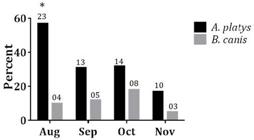ABSTRACT:
Hemoparasitic infections are tick-borne diseases, which affect animals and humans. Considering the importance of canine hemoparasitic infections in veterinary clinics, this study aimed to determine the occurrence of Anaplasma platys, Ehrlichia canis and Babesia vogeli in blood samples from 182 dogs not domiciled in the city of Pato Branco, southwestern region of Paraná State, Brazil, using polymerase chain reaction (PCR). The prevalence of A. platys and B. vogeli was 32.9% and 10.9% respectively, and A. platys infection prevailed (p<0.001). The number of dogs positive for A. platys was larger in Winter (p<0.05). All blood samples were negative for E. canis. In the dogs, infestation by Amblyomma cajennense predominated over that by Rhipicephalus sanguineus (p<0.001); but there was no significant association between PCR and the variables presence of ticks, sex and age. Dogs infected by A. platys and B. vogeli showed thrombocytopenia, lymphopenia and leukocytosis; but there was no correlation between such hematological changes and infection by hemoparasites. This appears to be the first molecular study that demonstrates the existence of A. platys and B. vogeli in dogs from the southwestern region of Paraná.
INDEX TERMS:
Anaplasma platys; Ehrlichia canis; Babesia vogeli; dogs; Paraná; canine thrombocytic anaplasmosis; canine monocytic ehrlichiosis; canine babesiosis; PCR

 Thumbnail
Thumbnail
 Thumbnail
Thumbnail
 Thumbnail
Thumbnail
 Thumbnail
Thumbnail



